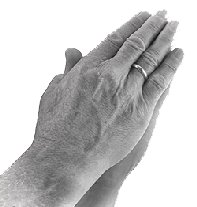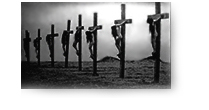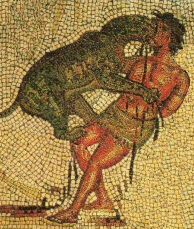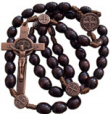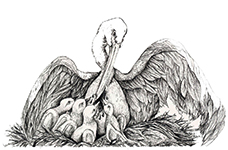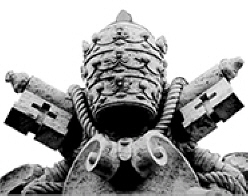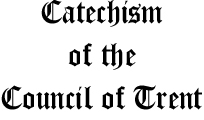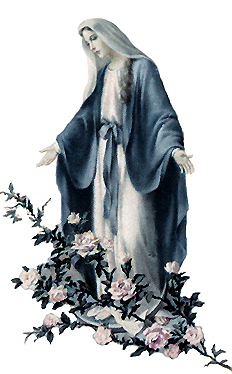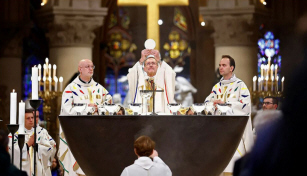|
Martyrology for Today
|
| The New Altar of the Catholic Left | The New Altar of the American Left |
| Notre Dame Cathedral, Paris | New York City |
One Catholic writer aptly called the new altar,
“a
sort of stretched salad bowl.”
___________________________________________________________________________
The Most Urgent Question of Our Time:
“When the Son of Man Comes, will He Find Faith on Earth?”
(St. Luke 18.8)
No
more stunning,
no more frightening, and perhaps no more ominously portentous
words are spoken in all the Gospels, in fact, in the
entire New Testament — perhaps even in the entirety
of Sacred Scripture itself; words that have become increasingly
fraught with significance with every passing year of
the most unfortunate papacy of Francis — a papacy not
just likely … but I believe with certainty … will
be understood not simply as among the worst … but the
worst … the most destructive to the Faith and to the
Church in the annals of 2000 years of Church history.
Indeed, with every generation following that devastating
Second Vatican Council — that scorched earth assault
on Tradition and historical Catholicism — the question
increasingly verges on an implied and obvious answer.
Indeed, we must wonder if the question that Christ poses
… “When the Son of Man comes will He find Faith on earth?”
… is, in fact, spoken of this generation, or of one
soon — very soon, to come.
As with so many of Christ’s teachings, this troubling question
is too often and too deftly explained away — especially
by the overwhelming number of the liberal theologians
and bishops who have proliferated and multiplied since
1962 — which is to say, by “the
learned and the wise”. If we heed them, it would
appear that either Christ does not know what He
is saying, or we do not know what He is saying
— although we all agree that He said something
... that sounds suspiciously clear.
We must, however, pay careful attention to these twelve
words, …. perhaps more now than at any
other time in Church history.
“When the Son of Man
comes will He find Faith on earth?”
These are twelve words, however, to which we must pay careful attention, perhaps more now than at any other time in Church history.
However reluctant we are to take Christ at His word — which becomes increasingly inconvenient to us — we must recognize that Jesus never spoke idly: His words, His teachings — and yes, His Commandments — were always uttered to one explicit end: the salvation of souls — attaining to Heaven and everlasting happiness and to avoiding Hell and eternal misery.
The Jewish religious authorities — “the learned” of His own time — had scornfully dismissed Christ’s warning that not so much as stone would remain standing in the great Temple 1 ... the very Temple within which, 70 years later, these words were fulfilled when Rome laid waste in days what took 46 years to build.
We tend to view such alarming statements made by Jesus
— and there are many — with the same scorn and disdain
today.
Indeed ... what has become of the “Faith of our Fathers?”
A mere fifty years ago we ourselves would have instinctively replied “Of course He will find faith! There simply must be some deeper, some obscure and less evident meaning to this that we do not presently understand — and what He appears to be saying, He is not really saying at all. Surely the “learned” of our own day can deftly explain the answer to this troubling question. In the end, they will conclude, Jesus is really asking something entirely different from what He appears to be asking and that it has nothing to do with our very real defection from the Faith.”
It is likely that many Jews of Jesus’ time — both the learned and the unlearned — had replied in much the same way. In fact, they did.
In other words, to us, our faith, the Faith of the Catholic Church for two millennia, could no sooner disappear than ... well, the stones of the great Temple 2000 years ago!
If, however, we take a careful inventory of our present
and undeniably dismal and increasingly scandalous situation
in the Church — especially as it has unfolded in the
last five decades — Jesus does not quite appear as ...
“perplexing” ... as so many apparently make Him to be.
Candidly
Ask yourself the following:
Has the Faith — the Catholic Faith — flourished in the last 50 years, or has it withered?
Are vocations to the Priesthood and Religious life growing or dwindling?
Are Catholics having more children or are they having fewer children?
Are Missionary efforts, to the end of (dare we say it?) “conversion” as mandated by Christ encouraged as intrinsic to Catholicism — or are they discouraged as impolite, obtrusive, culturally imperialistic and inherently inimical to the “Ecumenical spirit of Vatican II” — especially as interpreted by Pope Francis for whom “proselytism is solemn nonsense,” to use his own words, words that mock the sacrifices of countless missionary saints through the 2000 years preceding Vatican II’s “more enlightened” understanding of the Great Commission*?
Rather, we find that “conversion” to Christ and His Church is actively discouraged — that especially under Pope Francis it is no longer understood as a holy and inherently necessary endeavor — instead, it is disdained, even dismissed, as “socially and culturally incorrect” — indeed, we find that promoting our Catholic Faith — as Christ has commanded us to— has been forbidden by Francis and his “progressive” coterie of feckless and disaffected cardinals and bishops! What pope, prior to Vatican II, could ever have envisioned this?
Is our understanding of the Catholic Church, as an absolutely unique institution indispensable to the ordinary means of salvation, emphasized as urgently today (if it is emphasized at all) as it was a hundred years ago? Fifty years ago? Indeed, is the concept itself — of the singularity and indispensability of the Holy Catholic Church — still deemed an actual dogma and a viable concept at all?
For all our insolence and equivocation, we know the answers, and we are uncomfortable with them, for they fly in the face of Christ and all that He taught — to say nothing of Sacred Scripture, Holy Tradition, and the Sacred Deposit of the Faith entrusted to the Catholic Church by God Himself.
Indeed, Christ’s question takes on a greater sense of
urgency still, for the sheep are scattered and confused
as never before. The papacy of Francis has been disastrous
for the Church. Why? Precisely because he has taken
Vatican II to its logical conclusion: the irrelevance
of the Church.
Ubi
est Pastor?
Where is the Shepherd? Who is earnestly addressing this spiritual malaise and religious decay due to the indolence and dereliction of the vast majority of American and European bishops who appear far more eager for secular plaudits than the now quaint and discredited notion of “the salvation of souls.” Pope Francis has effectively declared this mandate defunct in favor of the rehabilitation of bodies, societies, economies, and “the environment”. That the passing material environment of man is infinitely less important than the eternal abode of his soul, often appears to elude Francis. Indeed, it appears to elude most Catholics whose mantra increasingly coincides with the world’s: Social activism! ... not interior conversion away from this world ... and to Christ.
Shame! Shame on us! By our silence, our fear of being disparaged by “other Catholics” for the sake of Christ, we condone this travesty — are complicit in it ... even promote it!
What will motivate us to recognize, and to redress, this frightful and ultimately deadly state of affairs?
There are, after all, other contenders in this world for the souls of men ... seen and unseen! As our own wick smolders, others blaze! The burning Crescent of Islam, poised like a scimitar, and every bit as deadly, glows and grows in the east, and with it, not an ethnic, but a Religious Cleansing to which the world remains indifferent — an expunging of every vestige of Christianity in partibus infidelium. And even Islam has its secular collaborators: the European Union — once a continent raised up from utter barbarism to a civilization formed and ennobled by its Catholic heritage — will no longer tolerate the inclusion of its indissoluble Christian heritage within its Constitution. Not only does it thoroughly repudiate its own Christian cultural heritage — it prohibits it — even banishes it! This is nothing less than self-loathing. And perhaps it ought to be.
Surely, then, in our effort to remedy this impending state of dissolution, we will first turn to our bishops, since they are, preeminently, the “Teachers and Guardians of the Faith”. But more often than not — much more often than not — in the well-appointed office at the end of the corridor we do not find a shepherd of souls but a deeply sequestered, occasionally avuncular, and predictably remote ... “administrator.”
Relegating his prime responsibility as Teacher and Promoter of the Faith ... to others, in the form of Lay committees and subcommittees largely “chaired” by liberal Catholics more concerned with social issues than the salvation of souls, are we confident that the patrimony of our faith will somehow percolate through this strata of already contaminated soil and reach our children authentically and intact? Is our fear mitigated ... or further exacerbated ... by our bishops’ resolute lack of diligence in being attentive to what Catholic colleges and theologians in their own dioceses are really teaching — and who are teaching the teachers ... who, in turn, are teaching our children?
Do you think that your bishop actually — that is to say, cognitively — is aware of, or even concerned with — what the teachers themselves are actually teaching?
Not in this diocese. Not in Boston. In fact, the former Cardinal Sean Patrick O’Malley had routinely feted, praised, and held up as exemplary, the clueless “Catechists” who churn out our children to the Sacrament of Confirmation — with no clue whatever of that in which they are being confirmed. By comparison, even the dismal failure of our public schools in Boston must be deemed a stunning success.
For most of us — especially in the Archdiocese of Boston, but no less elsewhere — the answer is, as they say, a “no-brainer:” it is a universally resounding no. Most of us find, to our growing dismay and deepening cynicism, that our bishops appear to have “more important,” more ... “pressing” things to do ... than to communicate the Faith to the faithful ... especially the children.
Really, we beg the question: if no one teaches the teachers
— who, then, teaches the children? If they are not brought
the faith by those to whom it has been entrusted — the
bishops, the episcopacy — who will bring it to them?
Will they —
how can they — acquire the Faith
... if no one brings it to them? Saint Paul is very
clear about this:
“How then shall they call on him, in whom they have not believed? Or how shall they believe him, of whom they have not heard? And how shall they hear, without a preacher? And how shall they preach unless they be sent ...?” (Romans 10.14-15)
Ask yourself candidly: do you know more ... or less ...
of your Catholic faith than your children? Very likely
more — although, in all honesty, it is probably little.
You politely assent to the now quaint Catholic notion
that “parents are the primary teachers of their children,”
but knowing little of your own Faith, you simply shell
out $175.00 per child and pan off this grave responsibility
to others of whom you know nothing, and who themselves
largely know nothing of the faith they presume to teach.
You go through the motions as careless of what your
children are taught in their 10 years of “Religious
Education” as your bishop is of what the teachers teach.
10 years later, and $1500 poorer per child, you scratch
your head and wonder why Johnny still does not know
God, and why Judy never goes to Mass — and yet we have
agreed that you know more than your children ...
What, then, we must ask — with growing apprehension
— will your children teach their children
...?
What will they — who know even less than
you
— teach those who know nothing?
Total Ignorance
The momentum, as we see, is inexorable — until it culminates in total ignorance: every generation knows less of their faith than the generation preceding it. It is, in the end, the devolution from doctrine to legend, from legend to fiction, and from fiction to myth.
That is not just a poor, but a stultifying and ultimately deadly patrimony.
This default — at every level — in transmitting the authentic Catholic faith intact ... leaves Jesus’ question very suddenly very real.
“Recently, a Gallup poll was taken on Catholic attitudes toward Holy Communion. The poll showed serious confusion among Catholics about one of the most basic beliefs of the Church. Only 30 percent of those surveyed believe they are actually receiving the Body and Blood, soul and divinity of the Lord Jesus Christ under the appearance of bread and wine.”
The problem is more than mathematical; as we have seen,
it is exponential. 70% of Catholics do not possess this
most fundamental, this most essential understanding
of the core article of genuine Catholic doctrine: that
“Unless you eat of the flesh of
the Son of Man, and drink His Blood, you have no life
in you.” Heavy stuff!
It is not just a matter of the greatest concern, but nothing
less than a matter of the gravest dereliction that most
Catholics do not realize — do not know — that the
very Mass itself is an abbreviation of “The Most
Holy Sacrifice of the Mass”, and that it is really a
Sacrifice, the actual re-enactment of Calvary
before their very eyes!
This failure of understanding ... culminates in a failure
in Faith. It possesses, in significant ways, the remorseless
characteristics of mathematical certainties. Not understanding,
grasping — having never been taught — the most elementary
features of the faith, how can they be understood to
possess what they have not acquired, and how can they
transmit, pass on, what they do not possess? It is inescapable.
Prognostication, of course, is for fools.
But the words of Christ are certainties that will come to pass.
“Weep not for Me, but for your children,” 5 Christ told the sorrowing women on the road to Calvary.
Jesus’ question, then — “When
the Son of Man comes will He find faith on earth?”—
is not a “rhetorical question” at all; it is a question
fraught with enormous significance ... the frightful
answer to which appears to be unfolding before our very
eyes ... but that is if you take Christ at His word
— and given Jesus’ track record on things yet to come,
we would do well and wisely to give pause for more than
thought.
Are you worried now ...? Not nearly enough.
And this is all the more frightening still.
Geoffrey K. Mondello
Editor
Boston Catholic Journal
Comments? Write us: editor@boston-catholic-journal.com
___________________________________________________________________________
The Holy Catholic Faith
Where is it And Who is Keeping it?
Has the Post-Conciliar Church
Lost Custody of the Faith?
All indications are that is has
The “Dark Ages” — that disdainful term for the period in history following the collapse of the Roman Empire in 476 A.D. until the 15th century (a period correctly described as the Middle Ages) is understood by the secular world to have lasted roughly 1000 years, beginning in Florence, Italy.
Within the post-Conciliar Catholic Church, however, it appears that the term extends well beyond the 15th century; indeed, some 500 years beyond it! According to contemporary Catholic thought articulated within the past five papacies, the “Dark Ages” really ended in 1965 at the conclusion of the Second Vatican Council. All the doctrines and teachings prior to that Council were only imperfectly, deficiently, and insufficiently articulated or defectively understood.
The 1000 Years of Darkness
Only
the Second Vatican Council finally attained to enlightenment
in the divine economy, and after 1,965 years of suspension,
it alone has provided the final, sufficient, and correct
understanding of God and Church, man and nature. Prior to
that, according to post-Conciliar thought, Catholics had
essentially lived in darkness, specifically the darkness
of the “pre-Conciliar Dark Ages.” It may be said that where
the Rational Enlightenment “saved the world from religion,”
Vatican II saved the Church from Catholicism.
Semen est sanguis Christianorum (The blood of Christians
is the seed of the Church) Tertullian, Apologeticum,
50
2004 Roman Martyrology by Month
|
2004 Roman Martyrology
December 16th in the Year of Grace 2025
This Day, the Sixteenth Day of
December 1. Commemoration of Saint Haggai, prophet, who, in the time of Zerubbabel, leader of Judah, admonished the people that the house of the Lord should be rebuilt, into which was to come the treasure of all nations.
2. Commemoration of many holy virgins, who, in Africa during the Vandal persecution under Hunneric the Arian king, endured the weight and heat of burning plates of metal, and happily completed the struggle of martyrdom.
3. In Ireland, Saint Bean, hermit.
4. At Cysoing in Artois, a province of Gaul, Saint Eberhard, who, Count of Friuli, founded there a monastery of Canons Regular, in which, some years after his death, he was piously buried.
5. At Vienne in Burgundy, Saint Ado, bishop, who, chosen as bishop from the monastic life, by composing a Martyrology greatly fostered the memory of the Saints.
6. At Seltz near Strasbourg in Lorraine, Germany, Saint Adelaide, who, as empress, possessed toward her household a dignified graciousness, a most upright dignity toward strangers, tireless in charity toward the poor, and of overflowing generosity in honoring the churches of God.
7. In Lucania, Saint Macarius of Collesano, monk, who, outstanding for humility and abstinence, wisely governed various monasteries of Mount Mercury and Latinianus.
8. At Genoa in Liguria, commemoration of blessed Sebastian (Salvatico) de Madiis, priest of the Order of Preachers, who preached the Gospel to the people of the region and advised on regular discipline in the convents.
9. At Turin in the Piedmont, blessed Mary of the Angels (Marianna) Fontanella, virgin of the Order of Carmelites, who was renowned for voluntary penances and the virtue of obedience.
10. At Riva presso Chieri in Italy, blessed Clement Marchisio, priest, who, pastor of this place, founded the Institute of the Daughters of Saint Joseph.
11. In the city of Nowe Miasto in Poland, blessed Honorat of Biala Podlaska (Florentius) Kozminski, priest of the Order of Friars Minor Capuchin, who devoted outstanding labor to ministering to penitents, to the preaching of the word of God, and to lifting the spirits of prisoners in jail.
12. Near the city of Mukdahan in Thailand, blessed Philip Siphong Onphitak, martyr, who, a father of a family, after the priest of the village of Song-Khon was driven out, was chosen leader of the Christian community and, when persecution began against Christians, was taken to the bank of the Tum Nok stream and killed by bullets.
__________________________________________________________________ And elsewhere in divers places, many other holy martyrs, confessors, and holy virgins. Omnes sancti Mártyres, oráte pro nobis. ℟. Thanks be to God.
|
| The 1956 edition below, issued during the pontificate of Pope Pius XII, is a revision of the typical edition of 1749, which had been promulgated by Pope Benedict XIV remained the foundational text for later updates throughout the 18th–20th centuries up to 2004 — the English translation of which remained the sole source of the Martyrology until the present translation of the 2004 Roman Martyrology by the Boston Catholic Journal in 2025. |
|
1956 ROMAN MARTYROLOGY
Tuesday, December 16th in the Year of Grace 2025
St. Eusebius, bishop of Vercelli
and martyr, mentioned on the
1st of August, and also on the 15th of this month.
Response: Thanks be to God. |
__________________________________________________________________________________________________________________________________
1959 Roman Martyrology by Month
| March | April | May | June | ||
| July | August | September | October | November | December |
__________________________________________________________________________________________________________________________________
Why the Martyrs Matter
Each
day we bring you a
calendar, a list really, of the holy Martyrs who had suffered
and died for Christ, for His Bride the Church, and for our holy
Catholic Faith; men and women for whom — and well they knew
— their Profession of Faith would cost them their lives.
They could have repudiated all three (Christ, Church, and Catholic
Faith) and kept their lives for a short time longer (even the
lapsi * only postponed their death — and
at so great a cost!)
What would motivate men, women, even children and entire families
to willingly undergo the most evil and painfully devised tortures;
to suffer death rather than denial?
Why did they not renounce their Catholic Faith when the first
flame licked at their feet, after the first eye was plucked
out, or after they were “baptized” in mockery by boiling water
or molten lead poured over their heads? Why did they not flee
to offer incense to the pagan gods since such a ritual concession
would be merely perfunctory, having been done, after all, under
duress, exacted by the compulsion of the state? What is a little
burned incense and a few words uttered without conviction, compared
to your own life and the lives of those you love? Surely God
knows that you are merely placating the state with empty gestures
…
Did they love their wives, husbands, children — their mothers,
fathers and friends less than we do? Did they value their own
lives less? Were they less sensitive to pain than we are? In
a word, what did they possess that we do not?
Nothing. They possessed what we ourselves are given in the Sacrament
of Confirmation — but cleaved to it in far greater measure than
we do: Faith and faithfulness; fortitude and valor, uncompromising
belief in the invincible reality of God, of life eternal in
Him for the faithful, of damnation everlasting apart from Him
for the unfaithful; of the ephemerality of this passing world
and all within it, and lives lived in total accord with that
adamant belief.
We are the Martyrs to come! What made them so will make us
so. What they suffered we will suffer. What they died for, we
will die for. If only we will! For most us, life will be
a bloodless martyrdom, a suffering for Christ, for the sake
of Christ, for the sake of the Church in a thousand ways outside
the arena. The road to Heaven is lined on both sides with Crosses,
and upon the Crosses people, people who suffered unknown to
the world, but known to God. Catholics living in partibus
infidelium, under the scourge of Islam. Loveless marriages.
Injustices on all sides. Poverty. Illness. Old age. Dependency.
They are the cruciform! Those whose lives became Crosses because
they would not flee God, the Church, the call to, the
demand for, holiness in the most ordinary things of life made
extraordinary through the grace of God. The Martyrology we celebrate
each day is just a vignette, a small, immeasurably small, sampling
of the martyrdom that has been the lives of countless men and
women whom Christ and the Angels know, but whom the world does
not know.
“Exemplum enim dedi vobis”, Christ
said to His Apostles: “I have given you an example.” And His
Martyrs give one to us — and that is why the Martyrs matter.
-
A Martyr is one who suffers tortures and a violent death for the sake of Christ and the Catholic Faith.
-
A Confessor is one who confesses Christ publicly in times of persecution and who suffers torture, or severe punishment by secular authorities as a consequence. It is a title given only given to those who suffered for the Faith — but was not killed for it — and who had persevered in the Faith until the end.
Geoffrey K. Mondello
Editor
editor@boston-catholic-journal.com
Boston Catholic Journal
Note: We suggest that you explore our newly edited and revised “De SS. Martyrum Cruciatibus — The Torments and Tortures of the Christian Martyrs” for an in-depth historical account of the sufferings of the Martyrs.
____________________________
* Those early Christians who renounced their Catholic Faith in times of persecution. When confronted with the prospect of torture and death if they held fast to their faith in Christ, they denied Him and their Faith through an act of sacrificing (often incense) to the pagan Roman gods and in so doing kept their lives and/or their freedom and property.
|
Totally
Faithful to the Sacred Deposit of Faith entrusted
to the Holy See in Rome
“Scio
opera tua ... quia modicum habes virtutem, et servasti verbum
Meum, nec non negasti Nomen Meum”
Copyright © 2004 - 2025 Boston
Catholic Journal. All rights reserved. Unless otherwise
stated, permission is granted by the Boston Catholic Journal
for the copying and distribution of the articles and audio
files under the following conditions: No additions,
deletions, or changes are to be made to the text or audio
files in any way, and the copies may not be sold for a profit.
In the reproduction, in any format of any image, graphic,
text, or audio file, attribution must be given to the Boston
Catholic Journal. |



